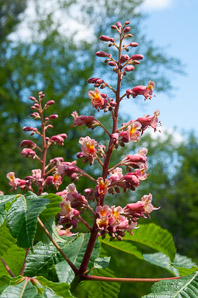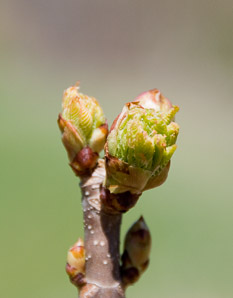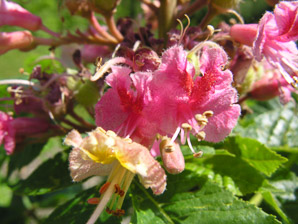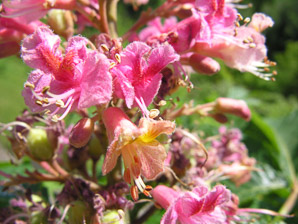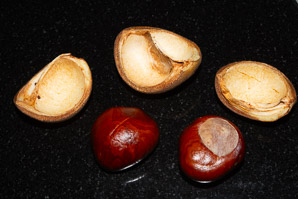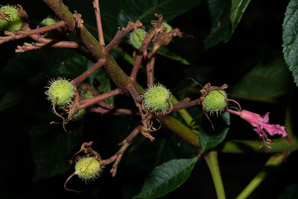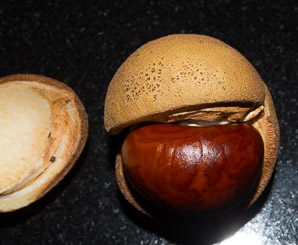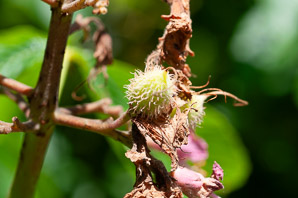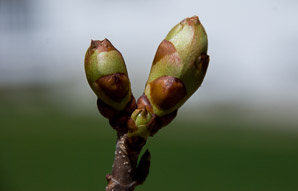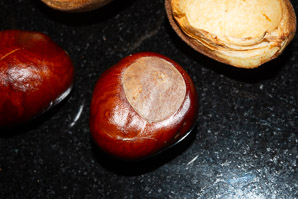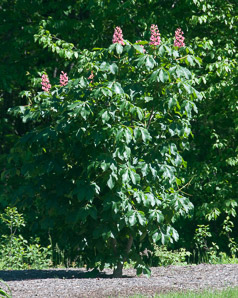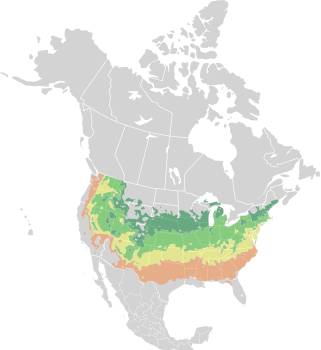
|
Aesculus × carnea ‘Atropunicea’ Red horse-chestnut
I don't have information on this cultivar, so this article describes Aesculus × carnea, a natural hybrid between red buckeye (Aesculus pavia) and horse chestnut (Aesculus hippocastanum). Mature red horsechesnut reaches heights of 40-70′ (12-21 m). It tends to be symmetrical in shape, looking a bit like a rounded cone. Identification: Red horsechesnut is not native to the United States, but it is found throughout zones 5-7. The beautiful pink blossoms make it a popular planting in yards and along streets. The tree has wide green leaves composed of five leaflets. Nuts are round, with thorny coats. Edibility: Poisonous. Online References:
Wikipedia (Aesculus × carnea) The Missouri Botanical Garden (Aesculus × carnea) The University of Connecticut Plant Database (Aesculus × carnea) References:
Sibley, David Allen, The Sibley Guide to Trees, Alfred A. Knopf, 2009, p. 327. 5/23/2008 · Tom and Susan’s, Pepperell, Massachusetts · ≈ 7 × 10″ (17 × 25 cm) 4/24/2007 · Tom and Susan’s, Pepperell, Massachusetts 5/29/2007 · Tom and Susan’s, Pepperell, Massachusetts 5/29/2007 · Tom and Susan’s, Pepperell, Massachusetts
Aesculus × carnea ‘Atropunicea’ description by Thomas H. Kent, last updated 25 Aug 2021. © FloraFinder.org. All rights reserved. |
10/30/2014 · Tom and Susan’s, Pepperell, Massachusetts · ≈ 9 × 6″ (22 × 15 cm) Shortly after flowering. · 6/4/2013 · Tom and Susan’s, Pepperell, Massachusetts · ≈ 8 × 5″ (19 × 12 cm) 10/30/2014 · Tom and Susan’s, Pepperell, Massachusetts · ≈ 6 × 4″ (16 × 10 cm) 6/17/2012 · Coastal Maine Botanical Gardens, Boothbay, Maine · ≈ 4½ × 3″ (11 × 7.9 cm) 4/24/2007 · Tom and Susan’s, Pepperell, Massachusetts 10/30/2014 · Tom and Susan’s, Pepperell, Massachusetts · ≈ 6 × 4″ (16 × 10 cm) 5/28/2008 · Tom and Susan’s, Pepperell, Massachusetts Range: Zones 5-8:
|
